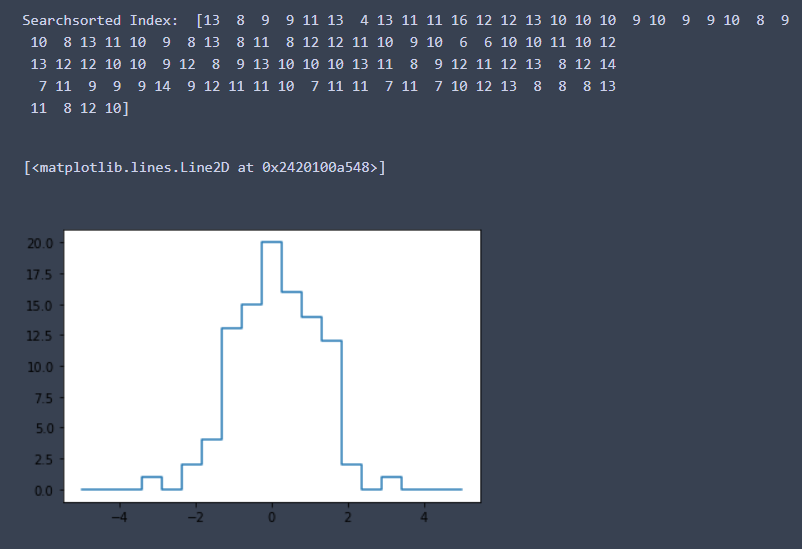給自己的Python小筆記 - NumPy中的 searchsorted用法 - 實作數據装箱(分組)
IPFS
Github連結

1. Searchsorted 函數
np.searchsorted(a, v, side='left', sorter = None)
說明: 於數組a中插入數組v,但不實際插人,而是返回一個索引列表,表示V中的元素應該插在a中哪個位置
重要提醒: 預設的狀況下sorter=None,也就是a數組要為升序數組,也就是要排好從小到大的數組
2. 參數

3. 實作
構建輸入數組
## 導人NumPy套件 import numpy as np ## 構建一個NumPy 數組 x = np.array([0,2,8,10,14,17,19,25,29,32,36,58]) x
執行結果
array([ 0, 2, 8, 10, 14, 17, 19, 25, 29, 32, 36, 58])
1. 插人單個元素
A. 插入輸入數組中沒有的元素(介於最大與最小值之間的數)
## 插入單個元素
ind1 = np.searchsorted(x, 28)
print ('Insert 28: ', ind1)
## 設定side=left
ind2 = np.searchsorted(x, 28, side = 'left')
print ('Insert 28 and set side = left: ', ind2)
## 設定side = right
ind3 = np.searchsorted(x, 28, side = 'right')
print('Insert 28 and set side = right: ', ind3)
執行結果
Insert 28: 8 Insert 28 and set side = left: 8 Insert 28 and set side = right: 8
B. 插入比輸入數組最小值更小的元素
## 插入比輸人數組的最小值更小的元素
## 設定side = left
ind1 = np.searchsorted(x, -2, side = 'left')
print('Insert 28 and set side = left: ', ind1)
## 設定side = right
ind2 = np.searchsorted (x, -2, side = 'right')
print('Insert 28 and set side = right: ', ind2)
執行結果
Insert 28 and set side = left: 0 Insert 28 and set side = right: 0
C. 插入比輸入數組最大值更大的元素
## 插入比輸入數组最大值更大的元素
## 設定side = left
ind1 = np.searchsorted (x, 99, side = 'left')
print ('Insert 28 and set side = left: ', ind1)
## 設定side = right
ind2 = np.searchsorted(x, 99, side = 'right')
print('Insert 28 and set side = right: ', ind2)
執行結果
Insert 28 and set side = left: 12 Insert 28 and set side = right: 12
D. 插入值跟輸入數組裡面的元素相等
## 播入信跟輸人數组裡面的元素相等
## 設定side=left
ind1 = np.searchsorted(x, 2, side = 'left')
print ('Insert 28 and set side = left: ', ind1)
## 設定side = right
ind2 = np.searchsorted(x, 2, side = 'right')
print('Insert 28 and set side = right: ', ind2)
## 當插人值跟輸入數組裡面的元素相等, side -'left'和s ide = 'right'結果是不一樣的
## 1.side = left: 會返回與相同元素一樣的位置
## 2.side=right:會返回相同元素的下一個位置
執行結果
Insert 28 and set side = left: 1 Insert 28 and set side = right: 2
結果:當插入值跟输入數組裡面的元素相等,side = 'left'和side = 'right'結果是不一樣的
- side="left": 會返回與相同元素一樣的位置
- side="right": 會返回相同元素的下個位置
2. 插入數組
## 插入值為一個數組
## 設定side = left
ind1 = np.searchsorted(x, [-2,3,8,9,26,28,58,66], side = 'left')
print ('Insert 28 and set side = left: ', ind1)
## 設定side = right
ind2 = np.searchsorted(x, [-2,3,8,9, 26, 28, 58,66], side = 'right')
print('Insert 28 and set side = right:', ind2)
執行結果
Insert 28 and set side = left: [ 0 2 2 3 8 8 11 12] Insert 28 and set side = right: [ 0 2 3 3 8 8 12 12]
結果: 返回一個數組
3. 當輸人數據沒有排好序(升序)的狀況
解決方法: 這時候就要設定sorter,透過np.argsort()找到沒有排好序的翰人數據的正確(升序)索引數組,再带進sorter就可以解決了
## 當輸入數組不是升序的狀況
## 隐機排列x數組
np.random.shuffle(x)
print ('x = ', x)
## 要先存放x的正確排序索引值
x_sort_index = np.argsort(x)
print('x_sort_index: ', x_sort_index)
## 接下來才能執行插人
## 設定side = left
ind1 = np.searchsorted (x, [-2,3,8,9,26,28, 58,66], side ='left', sorter = x_sort_index)
print('Insert 28 and set side = left: ', ind1)
## 設定side=right
ind2 = np.searchsorted (x, [-2,3,8,9, 26,28, 58, 66], side = 'right', sorter = x_sort_index)
print('Insert 28 and set side right: ', ind2)
執行結果
x = [29 19 10 58 2 17 14 36 25 32 0 8] x_sort_index: [10 4 11 2 6 5 1 8 0 9 7 3] Insert 28 and set side = left: [ 0 2 2 3 8 8 11 12] Insert 28 and set side right: [ 0 2 3 3 8 8 12 12]
應用範例:數據裝箱(分組)
- 舉例: 我們有1000 個值,想將它們分別放人各個不同的數組分組中,並快速地找到它們在分組數組中的位置, 此時就可以使用searchsorted()函數找到這些值應該被放人哪個箱子
import numpy as np
import matplotlib.pyplot as plt
## 隨機產生一個一維並擁有100個標準正態分布的值
np.random.seed(66)
x = np.random.randn(100)
## 自定義一個數據分組, 區間-5到5平均取20個數據點,每個區間為一個數據分組
bins = np.linspace (-5, 5, 20)
## counts為x數值落入區間的計數
counts = np.zeros_like(bins)
## 使用searchsorted, 來獲得x每個數據點在bins中落人的區間序號
i = np.searchsorted(bins, x)
print('Searchsorted Index: ',i)
## 使用at和add, 對x元素在每個區間的元素個數進行計算
np.add.at(counts, i, 1)
## 視覺化
plt.plot(bins, counts, ds = 'steps')
執行結果

喜欢我的作品吗?别忘了给予支持与赞赏,让我知道在创作的路上有你陪伴,一起延续这份热忱!

- 来自作者
- 相关推荐